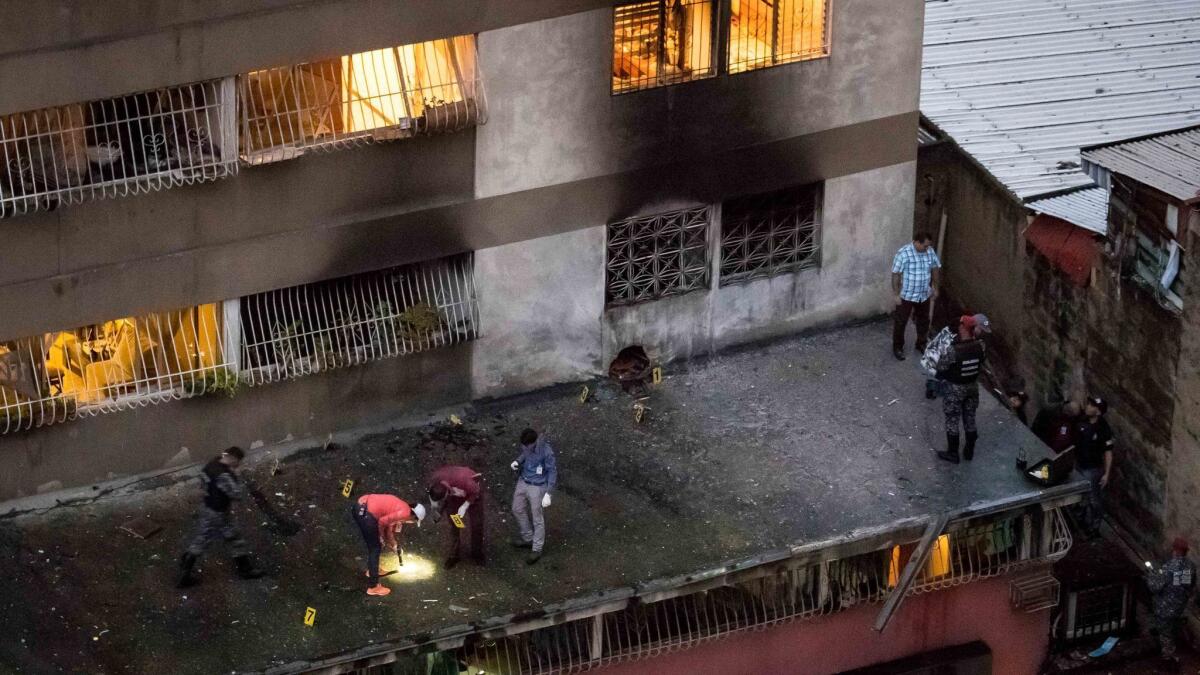Venezuela attack shows drones can become assassins. Hereâs how they can be grounded

As two explosives-laden drones flew toward Venezuelan President Nicolas Maduro at an event this past weekend, the remotely controlled aircraft headed into an area rigged with equipment designed to jam radio signals.
That technology was credited by Venezuelan officials with partly foiling an assassination attempt on Maduro. One of the drones lost control, hit a building and detonated, leaving a scorch mark on the side; the other exploded over uniformed guardsmen, injuring seven.
The attack â apparently the first of its kind â confirms the fears of some security officials that cheap, commercially available drones could be used for violent acts. And it highlights efforts to develop counter-drone technology, a market defense industry analysts expect will only grow.
The Defense Department has spoken for years about new technologies that would give ânon-state actorsâ the ability to strike against U.S. forces, bases and allies, said Mark Gunzinger, senior fellow at the Center for Strategic and Budgetary Assessments think tank. He said the Venezuelan drone attack was the first time he had heard of a drone being used like this against a public figure.
The airspace around Washington, D.C., is the most restricted in the nation. Drone flight is prohibited within a 15-mile radius of the Ronald Reagan Washington National Airport, unless an operator has specific authorization from the Federal Aviation Administration. Nonetheless, a quadcopter crashed on the White House lawn in 2015.
Two years earlier, a drone crash-landed in front of German Chancellor Angela Merkel at a campaign event in Germany.
âThis is just another case where weâre seeing unmanned systems technology being used for just that purpose,â Gunzinger said. âI guess we should be surprised they havenât been used before for that purpose.â
Jamming, or interrupting, the radio frequencies that link a specific drone with its controller is the most common anti-drone measure, said James Lewis, senior vice president at the Center for Strategic and International Studies think tank. That technology, which was used in Venezuela, can cause confusion and might be used to force the drone to the ground, however unpredictably. It is illegal for nongovernmental entities to use such jammers.
Researchers at Aerospace Corp. in El Segundo have been working to perfect a different type of control over the radio frequencies drones use to communicate. A team there has investigated the possibility of isolating the exact frequency used by a drone at a specific time. In several tests, the researchers were able to successfully take over the unmanned aerial vehicleâs controls and land it safely.
Nets are another common technique used to nab a drone in close proximity to a sensitive or high-risk area, Lewis said. And companies such as Raytheon Co. have developed directed-energy systems to shoot drones out of the sky.
Raytheonâs Phaser uses high-powered microwaves to fry errant dronesâ circuits. The microwaves of energy âinduce very, very small surges of current in electrical circuits, disrupt it and burn it out,â causing the drone to lose guidance, Gunzinger said. Raytheon has billed its system as a way to potentially counteract swarms of dozens or hundreds of tiny drones.
Boeing Co. has developed a compact laser weapons system that disabled a drone in about 15 seconds with a 2-kilowatt laser during a demonstration several years ago.
There are also less-aggressive options.
Drone manufacturer DJI, the maker of the DJI M600 drone used in the Venezuela attack, has developed geofencing software that puts a virtual boundary around sensitive areas, such as wildfires, so that rogue drones canât enter and are forced to hover in place if they attempt to fly through.
The China company has also developed a remote identification system for its drones known as AeroScope. Using a box with two antennas and an attached screen, airports, fire and police departments or other security agencies can listen to the radio link the drone uses to communicate with its handheld controller.
That radio link has encoded information about the droneâs serial number, where it took off from, where itâs going and where the pilot is, said Adam Lisberg, DJI spokesman.
He said the company has demonstrated that technology to various government agencies and had âproductive discussionsâ about its remote identification platform with authorities in the U.S. and Europe.
âSecurity forces are looking for a tool that helps them shrink the size of a haystack so they can find that needle,â Lisberg said.
The FAA is also considering implementing a system for remote drone identification and tracking, which would send information such as the droneâs owner, a unique identifier for the craft and tracking details to an agency-approved internet database.
But Gunzinger said the U.S. will need to continue thinking broadly about how small, inexpensive drones could be used and what they might be able to do in the future.
âWeâre still on the very front end, the leading edge of this technology,â he said. âThis technology is going to increase in sophistication. Itâs going to proliferate more widely. And we need to really think hard about how we can protect not just our politicians and soldiers but the U.S. public against terrorists and others who might use this in harmful ways.â
Twitter: @smasunaga
More to Read
Inside the business of entertainment
The Wide Shot brings you news, analysis and insights on everything from streaming wars to production â and what it all means for the future.
You may occasionally receive promotional content from the Los Angeles Times.











